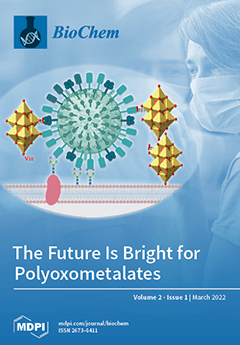Polyoxometalates (POMs) are clusters of units of oxoanions of transition metals, such as Mo, W, V and Nb, that can be formed upon acidification of neutral solutions. Once formed, some POMs have shown to persist in solution, even in the neutral and basic
[...] Read more.
Polyoxometalates (POMs) are clusters of units of oxoanions of transition metals, such as Mo, W, V and Nb, that can be formed upon acidification of neutral solutions. Once formed, some POMs have shown to persist in solution, even in the neutral and basic pH range. These inorganic clusters, amenable of a variety of structures, have been studied in environmental, chemical, and industrial fields, having applications in catalysis and macromolecular crystallography, as well as applications in biomedicine, such as cancer, bacterial and viral infections, among others. Herein, we connect recent POMs environmental applications in the decomposition of emergent pollutants with POMs’ biomedical activities and effects against cancer, bacteria, and viruses. With recent insights in POMs being pure, organic/inorganic hybrid materials, POM-based ionic liquid crystals and POM-ILs, and their applications in emergent pollutants degradation, including microplastics, are referred. It is perceived that the majority of the POMs studies against cancer, bacteria, and viruses were performed in the last ten years. POMs’ biological effects include apoptosis, cell cycle arrest, interference with the ions transport system, inhibition of mRNA synthesis, cell morphology changes, formation of reaction oxygen species, inhibition of virus binding to the host cell, and interaction with virus protein cages, among others. We additionally refer to POMs’ interactions with various proteins, including P-type ATPases, aquoporins, cinases, phosphatases, among others. Finally, POMs’ stability and speciation at physiological conditions are addressed.
Full article



